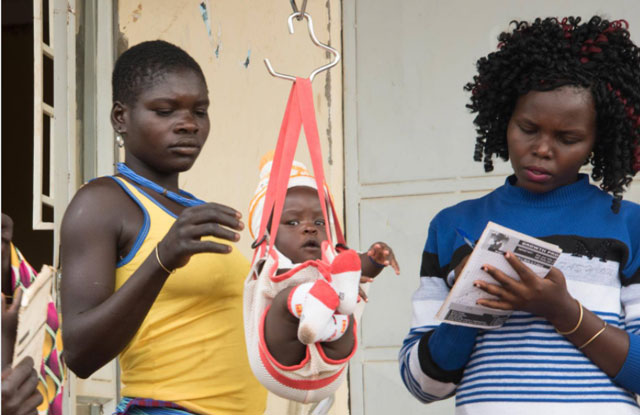
We spoke with Dr. Richard Kajura of the Makerere University School of Public Health about how the country significantly reduced prevalence of the condition by improving poverty, health, nutrition, education, and water and sanitation – by Exemplars News — August 04, 2022
SPECIAL FEATURE | THE INDEPENDENT | In the 1990s, Uganda began to stabilize after years of civil war. The government implemented more effective policies that led to significant gains in poverty reduction, health, nutrition, education, and water and sanitation, across the country. Notably, one of the things that also started to improve was the country’s stunting rate, which declined from 48 percent in 1988 to 29 percent in 2016.
This was all the more remarkable because Uganda didn’t have a plan to reduce stunting. Instead, the country illustrates how multi-sectoral efforts to achieve progress on a range of health and socio-economic indicators can deliver significant reductions in childhood stunting as well as, or potentially better, than a focused – but narrow – health sector intervention. For example, between 2002 and 2016, Uganda’s extreme poverty rate decreased from 66 percent to 41 percent. During the same period, child mortality rate dropped by two-thirds and the maternal mortality ratio dropped by one-third. Further, literacy among 15- to 24-year-old individuals reached 90 percent by 2018, compared to 70 percent in 1990 – and young women were just as likely as young men to be able to read.

One thing that was unique to Uganda’s experience, however, was that it showed a tightly linked relationship between ownership of insecticide-treated bed nets—a proxy for the country’s rapid progress in controlling malaria — and an increase in children’s height for age (HAZ) scores. Between 2009 and 2014, the number of households in the country with at least one bed net doubled.
🔵 We spoke with Dr. Richard Kajura, a Research Associate at the Makerere University School of Public Health, about new research published by Exemplars in Global Health into the determinants of stunting reduction in Uganda.
Could you describe the stunting situation in Uganda prior to 2000? What was life like for families and especially for children?
Dr. Kajura: Stunting before 2000 was high, in the 40 percent range. We did not know why it had stayed [in that range] for a few decades. It was puzzling. There was less known about it and it had less attention because it wasn’t really recorded as a disease. There was more attention paid to infectious diseases at that time. Most people lived in the country, close to 80 percent were in villages. There were longer distances to health facilities where they could get such information or health workers who could give them such information or tell them their child was not growing very well. There was also – and still is – a stigma for a mother to report to a health facility that their child is not growing very well, to say I’m going to a health facility to be advised to feed my child. That your husband is failing to look after my child. That is an embarrassment. Diet was also an issue – most people didn’t know that children, especially those under five, need special types of food in addition to breast milk. Culture was also an issue because the child is always secondary. Heads of households are given a bigger portion of food. There were also some secondary factors, such as climate. People here depend on the rain for water. The level of immunization was also low and there was a lot of disease. That was the life then.
What started to change in the country after 2000 and why did it start changing?
Dr. Kajura: The game changer was political will to look at some policies. After 2000, there was also a big decentralization in the country – power was transferred to the districts with the aim of bringing services near to the people. Under this policy, we started to have more health facilities. In this country, we actually have five delivery mechanisms for health care: health center one, health center two, health center three, health center four, and the hospital.
Health center one is a volunteer Village Health Team (which delivers basic health services and education). They are supervised by health center two, where they do immunizations. At health center three, they do deliveries. Pregnant mothers go to health center three, which is always within about five kilometers under WHO guidelines. The mothers get health information, are monitored, and given folic acid, etc. All this helps the slow-growing child when still in the womb. The mother is also given information in terms of looking after her children, hygiene, feeding and monitoring for signs of sickness. Health center four does management of malnourished children, inpatients, and planning for cases at the hospital level. Then there is a regional referral hospital where they do referrals and there’s a senior nutritionist that also supports other hospitals in the region. That’s how this policy of decentralization put health service near to the people and was a game changer.

The other thing that changed around 2011 was the Uganda Nutrition Action Plan, which noted that stunting and issues related to nutrition should not be housed in one sector or in one ministry. They said about nine [ministries] should be working concurrently to address issues that could reduce stunting. Besides the health ministry, the ministries that do agriculture, finance, local government, the water ministry, the ministry of education, etc. now had to address a common goal of doing indirect and direct interventions. The other ministries all do things that could directly affect stunting. After this we also started universal primary education – that was also a game changer, in my view. With universal primary education, these children, who a few years later will become mothers, can be told about caring for their children. It meant that when they got to health facilities, they were able to take information from the health workers, and they’ll be able to comprehend what the health workers tell them and practice what they’re told.
Could you describe the strategy Uganda adopted to so dramatically reduce its stunting rate?
Dr. Kajura: I think the biggest strategy was to improve the enabling environment. They say the Uganda Nutrition Action Plan was a game changer. But you need to know that the country has never had a strategy specifically aiming at reducing stunting. When our stunting rate decreased from the 40 percent to the 30 percent range – It’s now about 29 percent – it took us by surprise. We wondered if the number was right or whether we should start asking what was responsible. People were working in silos independently and there was a lack of documentation.
But I was starting to see that there was likely a linkage between things that were being done with stunting reduction. One thing we learned from our recent work was [the link] with malaria control campaigns. People didn’t know that we weren’t just controlling malaria because children were dying of malaria. We came to learn that as they controlled malaria, stunting was decreasing. The explanation was very simple – when you remove disease and improve food intake, then stunting decreases. Another strategy [that contributed] was folic acid supplementation to all mothers that go to the health facilities, which reduced anemia.
Finally, an important strategy has been poverty reduction and improving income at household level. As I mentioned at the beginning, there is a lot of subsistence farming in this country and close to three quarters of the population are in agriculture. When we put more into the agricultural section, we improved households’ incomes and there was a reduction of poverty. People could look after themselves if they became sick. They could buy what they want to utilize in a household. Their sanitation level and living environments improved. Diseases decreased and the intake of food increased and children grew well.
Let’s dive a little deeper into water and sanitation. Why was it so important?
Dr. Kajura: There was a policy around 2020, to improve the quality of water to minimize disease. Quality water means there will be less people falling sick, and there will be less frequency of a child going to hospital. Disease compromises growth. Another aspect is that when there is water, people are able to cook, and do more than two meals a day. In places where there is less water, that can also compromise the number of meals consumed in a day. Because, they have to ration the amount of water they have.
What are the biggest takeaways from this research? And what are the lessons Uganda may have for other countries?
Dr. Kajura: I think one of the big lessons is that tackling stunting or child stunting shouldn’t be left to specific, or direct nutrition interventions only. Learning that children sleeping in a [mosquito] net can reduce stunting tells us that there are other indirect factors or not directly utilized by the child that can actually be in play. For example, family planning is something that has to be addressed, because family planning means that before the child is brought in, the mother is prepared. Even though the child does not directly benefit, it gives that child spacing and the mother time before the next pregnancy, so that we minimize intrauterine reduction.
*****
This article first appeared on the Exemplars in Global Health platform. Exemplars in Global Health is a network of global experts, funders, and collaborators who share the belief that rigorously understanding global health successes can help drive better resource allocation, policy, and implementation decisions.
 The Independent Uganda: You get the Truth we Pay the Price
The Independent Uganda: You get the Truth we Pay the Price



